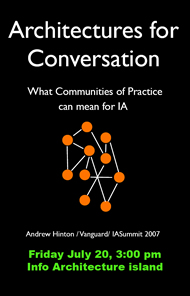I’ve been presenting on this topic for quite a while. It’s officially an obsession. And I’m happy to say there’s actually a lot of attention being paid to context lately, and that is a good thing. But it’s mainly from the perspective of designing for existing contexts in the world, and accommodating or responding appropriately to them.
For example, the ubicomp community has been researching this issue for many years — if computing is no longer tied to a few discrete devices and is essentially happening everywhere, in all sorts of parts of our environment, how can we make sure it responds in relevant, even considerate ways to its users?
Likewise, the mobile community has been abuzz about the context of particular devices, and how to design code and UI that shapes the experience based on the device’s form factor, and how to balance the strengths of native apps vs web apps.
And the Content Strategy practitioner community has been adroitly handling the challenges of writing for the existing audience, situational & media contexts that content may be published or syndicated into.
All of these are worthy subjects for our attention, and very complex challenges for us to figure out. I’m on board with any and all of these efforts.
But I genuinely think there’s a related, but different issue that is still a blind spot: we don’t only have to worry about designing for existing contexts, we also have to understand that we are often designing context itself.
In essence, we’ve created a new dimension, an information dimension that we walk around in simultaneously with the one where we evolved as a species; and this dimension can significantly change the meaning of our actions and interactions, with the change of a software rule, a link name or a label. There are no longer clear boundaries between “here” and “there” and reality is increasingly getting bent into disorienting shapes by this pervasive layer of language & soft-machinery.
My thinking on this central point has evolved over the last four to five years, since I first started presenting on the topic publicly. I’ve since been including a discussion of context design in almost every talk or article I’ve written.
I’m posting below my 10-minute “punchy idea” version developed for the WebVisions conference (iterations of this were given in Portland, Atlanta & New York City).
I’m also working on a book manuscript on the topic, but more on that later as it takes more shape (and as the publisher details are ironed out).
I’m really looking forward to delving into the topic with the attention and breadth it needs for the book project (with trepidation & anxiety, but mostly the positive kind ;-).
Of course, any and all suggestions, thoughts, conversations or critiques are welcome.
PS: as I was finishing up this post, John Seely Brown (whom I consider a patron saint) tweeted this bit: “context is something we constantly underplay… with today’s tools we can now create context almost as easily as content.” Synchronicity? More likely just a result of his writing soaking into my subconscious over the last 12-13 years. But quite validating to read, regardless :-)
I’m pasting the SlideShare-extracted notes below for reference.
Read the rest of this entry »



